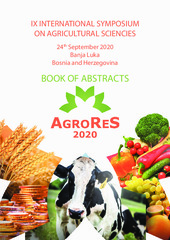Приказ основних података о документу
Bionomy of Parthenolecanium persicae (Fabricius) (Hemiptera: Coccidae) on grapevine in Serbia
| dc.creator | Dervišević, Marina | |
| dc.creator | Stojanović, Aleksandar | |
| dc.creator | Sivčev, Lazar | |
| dc.creator | Graora, Draga | |
| dc.date.accessioned | 2022-12-10T17:39:45Z | |
| dc.date.available | 2022-12-10T17:39:45Z | |
| dc.date.issued | 2020 | |
| dc.identifier.isbn | 978-99938-93-63-9 | |
| dc.identifier.uri | http://RIVeC.institut-palanka.rs/handle/123456789/588 | |
| dc.description.abstract | Parthenolecanium persicae (Fabricius) (Hemiptera: Coccidae) is a paleartic species found on over 70 host plants, with the highest damage being recorded on grapevine and plums. In Serbia, this one is more abundant on extensive orchards or physiologically weakened plants. Bionomy of P. persicae was studied from 2015 to 2019 in three localities: Aleksandrovac, Belgrade and Neštin. Sampling of plant material was performed throughout the year, in interval of 7 to 10 days during vegetation, or, once in month during plant dormancy. From each infested plant, five one- or two- years old twigs 20 cm long were taken. Sampled plant material with scale insect colonies was brought to the laboratory, where it was examined for scale insects presence and then deposited in glass cylinders for the rearing of scales insects and natural enemies. The determination of the eclosed parasitoids was performed by eng. Aleksandar Stojanović. P. persicae developed one generation per year and overwintered as second instar larva on grapevine shoot and trunk. Females emerged during April and early May, and oviposition was recorded in mid-May. Each female layed on average 2001 ± 3,4 white eggs. First instar larvae appeared during June. In the summer, they feed mainly on young shoots, leaves and leaf petioles. In late August and early September, second instar larvae were formed, which continue to feed until October when they migrated to shoots or hidden places on the trunks where they overwintered. Numerous colonies of P. persicae was recorded in the Belgrade locality, which resulting in discoloration, drying and premature leaf fall. In the vineyards of Aleksandrovac and Neštin, scale insects was present on individual plants, with no visible symptoms of damage. During our research, on the P. persicae we found 7 species of natural enemies. Of the parasitoids (Hymenoptera: Chalcidoidea), 6 species were eclosed: Coccophagus lycimnia (Walker), Eunotus obscurus Masi, Marietta picta (Andre) (Aphelinidae), Metaphycus dispar (Mercet), Metaphycus insidiosus (Mercet), Metaphycus maculipennis (Timberlake), (Encyrtidae), and from predators, the species Exochomus quadripustulatus L. (Coleoptera: Coccinellidae). | sr |
| dc.language.iso | en | sr |
| dc.publisher | Banja Luka : Poljoprivredni fakultet | sr |
| dc.rights | openAccess | sr |
| dc.source | Book of Abstracts : 9th International Symposium on Agricultural Sciences "AgroReS 2020", 24 September, 2020, Banja Luka, Bosnia and Herzegovina | sr |
| dc.subject | Bionomy | sr |
| dc.subject | Parthenolecanium persicae | sr |
| dc.subject | grapevine | sr |
| dc.subject | Serbia | sr |
| dc.title | Bionomy of Parthenolecanium persicae (Fabricius) (Hemiptera: Coccidae) on grapevine in Serbia | sr |
| dc.type | conferenceObject | sr |
| dc.rights.license | ARR | sr |
| dc.citation.spage | 81 | |
| dc.identifier.fulltext | http://RIVeC.institut-palanka.rs/bitstream/id/1947/bitstream_1947.pdf | |
| dc.identifier.rcub | https://hdl.handle.net/21.15107/rcub_rivec_588 | |
| dc.type.version | publishedVersion | sr |


